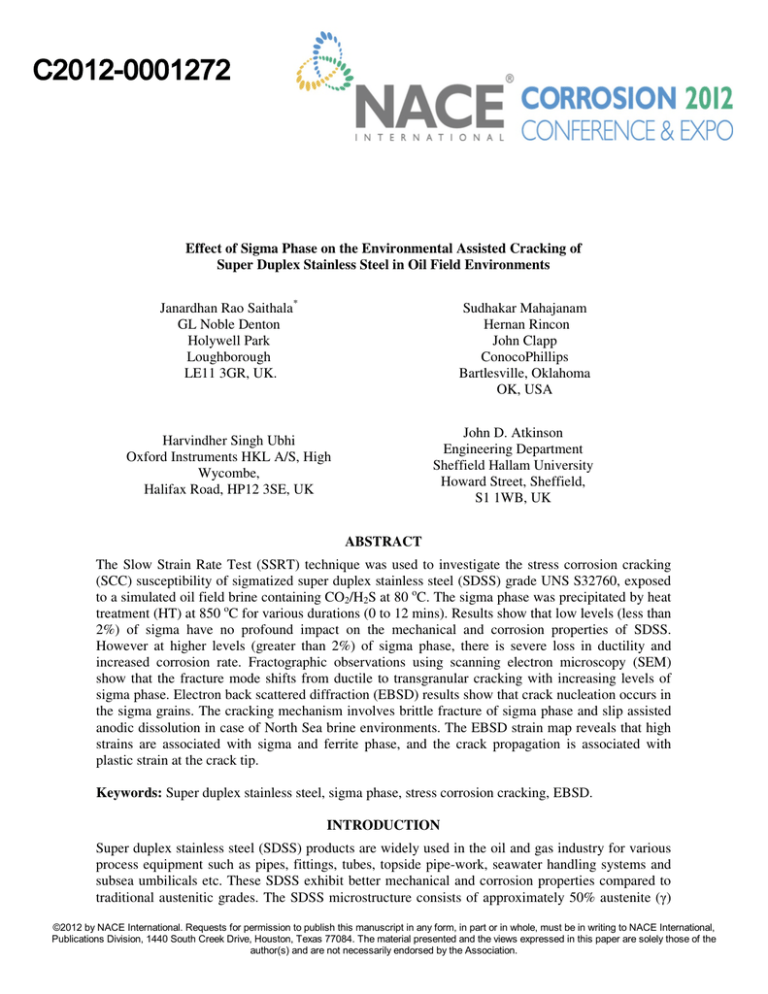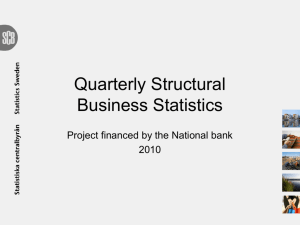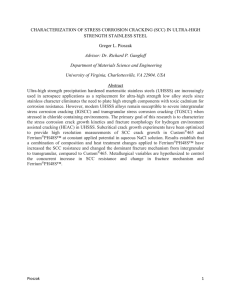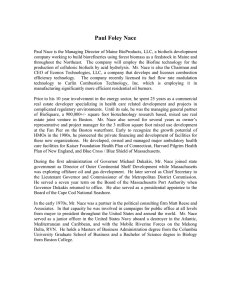Effect of Sigma Phase on the Environmental
advertisement

C2012-0001272 Effect of Sigma Phase on the Environmental Assisted Cracking of Super Duplex Stainless Steel in Oil Field Environments Janardhan Rao Saithala* GL Noble Denton Holywell Park Loughborough LE11 3GR, UK. Sudhakar Mahajanam Hernan Rincon John Clapp ConocoPhillips Bartlesville, Oklahoma OK, USA John D. Atkinson Engineering Department Sheffield Hallam University Howard Street, Sheffield, S1 1WB, UK Harvindher Singh Ubhi Oxford Instruments HKL A/S, High Wycombe, Halifax Road, HP12 3SE, UK ABSTRACT The Slow Strain Rate Test (SSRT) technique was used to investigate the stress corrosion cracking (SCC) susceptibility of sigmatized super duplex stainless steel (SDSS) grade UNS S32760, exposed to a simulated oil field brine containing CO2/H2S at 80 oC. The sigma phase was precipitated by heat treatment (HT) at 850 oC for various durations (0 to 12 mins). Results show that low levels (less than 2%) of sigma have no profound impact on the mechanical and corrosion properties of SDSS. However at higher levels (greater than 2%) of sigma phase, there is severe loss in ductility and increased corrosion rate. Fractographic observations using scanning electron microscopy (SEM) show that the fracture mode shifts from ductile to transgranular cracking with increasing levels of sigma phase. Electron back scattered diffraction (EBSD) results show that crack nucleation occurs in the sigma grains. The cracking mechanism involves brittle fracture of sigma phase and slip assisted anodic dissolution in case of North Sea brine environments. The EBSD strain map reveals that high strains are associated with sigma and ferrite phase, and the crack propagation is associated with plastic strain at the crack tip. Keywords: Super duplex stainless steel, sigma phase, stress corrosion cracking, EBSD. INTRODUCTION Super duplex stainless steel (SDSS) products are widely used in the oil and gas industry for various process equipment such as pipes, fittings, tubes, topside pipe-work, seawater handling systems and subsea umbilicals etc. These SDSS exhibit better mechanical and corrosion properties compared to traditional austenitic grades. The SDSS microstructure consists of approximately 50% austenite (γ) ©2012 by NACE International. Requests for permission to publish this manuscript in any form, in part or in whole, must be in writing to NACE International, Publications Division, 1440 South Creek Drive, Houston, Texas 77084. The material presented and the views expressed in this paper are solely those of the author(s) and are not necessarily endorsed by the Association. and 50% ferrite (α) phases. However if incorrectly heat treated, these materials suffer from intermetallic phase (IP) precipitation, such as sigma (σ) and chi, that will degrade the mechanical and corrosion properties. Therefore correct heat treatment of SDSS is critical to guarantee the product integrity. One way to avoid IP formation is by carrying out the heat treatment at optimum temperature conditions and maintaining a rapid quench rate. Sigma phase is generally formed when SDSSs are exposed to the temperature range of 700-900 0C even for very short time periods. The most critical temperature for σ-phase precipitation is 850 oC.1 Once σ-phase is introduced in the microstructure it is difficult to recover the optimum microstructure. Recent studies 2-3 discussed the effect of σ-phase on corrosion and stress corrosion, and highlighted the fact that deviation in quality can result in serious downtime for oil and gas production operations. Most of the earlier studies 4-9 conducted on investigating the stress corrosion cracking (SCC) behavior of SDSSs or duplex steels were conducted in either boiling chloride solutions (MgCl2, CaCl2, NaCl) or by applying controlled potentials in dilute environments.10 None of the above studies discussed the effect of σ-phase on SCC behavior in aggressive environments. There have been only a limited number of studies examining the behavior of sigma phase specific to SDSS materials tested in a simulated oil field environment. This particular study was conducted to investigate potential susceptibility to SCC of sigmatized SDSS exposed to simulated North Sea platform production brine. Samples containing varied levels of σ-phase are tested in mineral oil and North Sea brine to understand the failure behaviour of SDSS in the presence of σ-phase. Scanning electron microscopy (SEM) and electron back scattered diffraction (EBSD) techniques were used to investigate the cracking mechanism and the kinetics of σ-phase in the environmental assisted cracking process. MICROSTRUCTURE & CHEMICAL COMPOSITION The material used in the current study is UNS S32760 SDSS. The microstructure of SDSS, shown in Figure 1, consists of approximately 50% γ and 50% α phases. (a) (b) (c) Figure 1: Microstructure of SDSS (a) Phase map, (b) Inverse Pole Figure map, (c) Strain map. ©2012 by NACE International. Requests for permission to publish this manuscript in any form, in part or in whole, must be in writing to NACE International, Publications Division, 1440 South Creek Drive, Houston, Texas 77084. The material presented and the views expressed in this paper are solely those of the author(s) and are not necessarily endorsed by the Association. The material was solution annealed at 1080ºC followed by a rapid water quench. All the test samples were machined from a bar in the longitudinal direction. The chemical composition of the material is listed in Table 1. Table 1 Chemical Composition of Material Tested (wt %) Grade Cr N Mo Ni Cu W P S C Mn Si PREN UNS S32760 25.10 0.23 3.75 6.86 0.61 0.55 0.024 0.0004 0.024 0.51 0.24 41.16 EXPERIMENTS SSRT test technique: The SSRT method (ASTM G129) has been commonly used for screening corrosion resistant alloys (CRA) for SCC studies in a wide variety of environments including sour gas/oil production. These tests were conducted on UNS S32760 samples. One sample was as-received, while all the other samples were heat treated at 850 0C for 45, 180, 360, 720 s. This was done to intentionally modify the microstructure by precipitating IP, such as σ-phase. Figure 2 shows the time durations of the heat treatment of the SSRT tensile specimens. Figure 2: Heat treatment charts for SSRT specimens. (a) (b) Figure 3: (a) SSRT specimen, (b) Dimensions of SSRT specimen. Synthetic brine simulating the North Sea offshore platform production water chemistry was used for testing all the samples. The specification of the brine is included in Table 2. SSRT test methodology followed the procedures described in ASTM 129-00.11 Tests were planned to be conducted in mineral oil and CO2 saturated brine at 80 0C, 1 atm. for each alloy condition. Smooth tensile coupons with a nominal gauge diameter of 0.01 inch were used per NACE TM0198, 12 as shown in Figure 3. The test machine shown in Figure 4 was used for the current study. First the test coupon was fitted to ©2012 by NACE International. Requests for permission to publish this manuscript in any form, in part or in whole, must be in writing to NACE International, Publications Division, 1440 South Creek Drive, Houston, Texas 77084. The material presented and the views expressed in this paper are solely those of the author(s) and are not necessarily endorsed by the Association. the loading cell by screwing both coupon ends to the test machine grips. Test brine was introduced in the sealed autoclave and deaerated by vigorous sparging of N2 for at least 2 hours. Then the CO2-H2S gas mixture (60% CO2, 3% H2S, bal. N2) was bubbled through the brine until saturation. The temperature was then raised to 80ºC and kept constant, while the gas mixture was bubbled for the entire test period. At 80ºC, the specimen was pulled to fracture at a strain rate of 4x10-6 in/in/sec. Control tests were done using an inert environment, which in this case was CO2-free mineral oil. Figure 4: Test set up used to conduct SSRT tests. Table 2 North Sea production brine composition RESULTS & DISCUSSION Effect of sigma on SSRT testing in CO2/ H2S environment: The results of testing all the SSRT samples in the simulated North Sea and mineral oil at 80ºC are presented in Table 3. It is evident that for different HT durations (0, 45, 180, 360, 720 s) at 850ºC, different vol % of σ-phase (0. 0.02, 1, 2, 20) is formed in the SDSS microstructure. For accurate quantitative measurement of low levels of σ-phase, optical microscopy and EBSD were used. Typical nominal stress–strain curves generated from the SSRT tests are presented in Figure 5. Ultimate tensile stress values (UTS) seem to be independent of HT time up to 3 min at 850ºC. Above 3 min of HT, the strain values begin to drop severely. Figure 6 presents the effect of σ content on ductility ratio and fracture strain. The ductility ratio is a measure of ratio of reduction of area in mineral oil (ROAA) to reduction of area in environment (ROAB); for simplicity written as ROAA/ROAB. Above 2% σ level, SDSS suffers from severe reduction in ductility causing brittle failures. Between 2 to 20%σ, there was increased susceptibility to cracking, with ductility going down 70%. Thus, it appears that 2% σ-phase in the SDSS microstructure is the critical SCC limit. ©2012 by NACE International. Requests for permission to publish this manuscript in any form, in part or in whole, must be in writing to NACE International, Publications Division, 1440 South Creek Drive, Houston, Texas 77084. The material presented and the views expressed in this paper are solely those of the author(s) and are not necessarily endorsed by the Association. Along with ductility, fracture strain also drops dramatically due to the presence of σ-phase. For 1-2 vol % σ-phase, the fracture strain is 0.27; while it drops to 0.05 for 20 vol % σ-phase. Table 3 Slow strain rate test results in both mineral oil and CO2/H2S environments Figure 5: Effect of heat treatment on SSRT testing conducted in mineral oil and North Sea brine. Critical σ level Figure 6: Effect of heat treatment time on ductility ratio and strain at failure. ©2012 by NACE International. Requests for permission to publish this manuscript in any form, in part or in whole, must be in writing to NACE International, Publications Division, 1440 South Creek Drive, Houston, Texas 77084. The material presented and the views expressed in this paper are solely those of the author(s) and are not necessarily endorsed by the Association. (a) (b) (c) (d) Figure 7: Optical micrographs of samples after SSRT tests: (a) As-received in mineral oil, (b) Asreceived in brine, (c) HT (12 min) in mineral oil, (d) HT (12 min) in brine. Figures 7 (a-d) show photographs of the two materials (as-received and HT for 12 min) following SSRT testing in mineral oil and in the synthetic brine. It is evident that there is more necking observed in the as-received sample compared to the HT (12 min) one. (a) (b) Figure 8 (a) Fracture surface of as-received, and (b) HT (45 s) samples; after SSRT testing in brine. Figures 8 (a-b) show SEM fractographs of the two fracture surfaces after SSRT testing in brine. The as-received fracture surface contains dimpled ductile rupture features, whereas the HT (45 s) fracture surface has a few features indicative of quasi-cleavage fracture. The fact that a short heat treatment time of 45 s at 850 oC shifted the fracture mode from ductile to quasi cleavage indicates that SDSSs are very sensitive to σ-phase. The as received and HT (45 s) samples failed in about 24 h in a ductile ©2012 by NACE International. Requests for permission to publish this manuscript in any form, in part or in whole, must be in writing to NACE International, Publications Division, 1440 South Creek Drive, Houston, Texas 77084. The material presented and the views expressed in this paper are solely those of the author(s) and are not necessarily endorsed by the Association. fashion. This is in agreement with the literature wherein 2507 duplex SS exposed to H2S saturated environments retained its ductility over a wide temperature range (2-95 oC).3 Investigation of fracture surfaces from the other HT (6, 12 min) samples was also done using optical microscopy, SEM and EBSD examination, as shown in Figures 9-11. The results substantiate the SSRT results from Figures 5-6, wherein ductility reduces to lower levels with increasing σ-phase, indicating that the possibility of SCC conditions being achieved. The fracture morphology for the 20 vol% σ-phase is predominantly transgranular cleavage. (a) (b) Figure 9: Fracture surfaces of samples after SSRT testing (a) HT (6 min) showing ductile failure, (b) HT (12 min) showing brittle failure. (a) (b) Figure 10: SEM fractographs of (a) As-received fracture surface with dimpled features, (b) HT (12 min) sample with transgranular quasi cleavage fracture surface. (a) (b) Figure 11: EBSD phase map showing σ-phase (yellow), (a) 2 vol %, (b) 20 vol %. ©2012 by NACE International. Requests for permission to publish this manuscript in any form, in part or in whole, must be in writing to NACE International, Publications Division, 1440 South Creek Drive, Houston, Texas 77084. The material presented and the views expressed in this paper are solely those of the author(s) and are not necessarily endorsed by the Association. EBSD is one of the most accurate techniques to measure low levels of σ-phase as it will produce precise phase quantifications. Phase maps shown in Figure 11, taken at the gauge length crosssections of the SSRT samples, clearly highlight the difference in σ-phase content in the microstructure. Time-to-failure (TTF) comparisons between the various SSRT tests did not provide a clear correlation with increase in vol % of σ-phase. However, the TTF value for the 20 vol % σphase sample was 83% lower than the as-received one. Cracking mechanism of SDSS in CO2/H2S/Cl- environment: SEM examination of gauge length cross-sections after the SSRT tests indicated an abundance of crack initiation on the surface in both the 2 and 20 vol % σ-phase specimens as shown in Figure 12. (a) (b) Figure 12: SEM images of post SSRT samples along gauge length (a) 2 vol%, (b) 20 vol% σ-phase. (a) (b) (c) (d) Figure 13: (a) Crack propagation through the gauge diameter, (b) Selective phase pitting attack on gauge surface, (c) Selective phase attack of σ-phase, (d) Cracks in the σ-phase grains observed near the fracture surface. All images were taken on the HT (12 min) SSRT sample tested in Brine ©2012 by NACE International. Requests for permission to publish this manuscript in any form, in part or in whole, must be in writing to NACE International, Publications Division, 1440 South Creek Drive, Houston, Texas 77084. The material presented and the views expressed in this paper are solely those of the author(s) and are not necessarily endorsed by the Association. To gain further insight into the failure mechanisms, more detailed SEM examination was conducted on the HT (12 min) tested in brine, which showed cracking and selective phase attack. These images are shown in Figure 13. It appears that crack coalescence plays an important role as evidenced from Figure 13 (a). For controlled applied potentials in chloride environments, it has been reported that once cracks initiate in SDSS, crack coalescence and selective phase pitting attack dominate the failure process.10 One reason for this selective attack is difference in chemical composition of constituent phases. Detailed discussion on this mechanism occurring in duplex steels was already discussed elsewhere.15-16 (a) (b) α γ α γ =50 µm; BC+Pred+Pblue+Pyellow+Pgreen; Step=0.1 µm; Grid1809x963 Figure 14: EBSD phase maps for SSRT specimens (a) HT (6 min) with 2 vol % σ-phase, (b) HT (12 min) with 20 vol % σ-phase. Color coding: σ (yellow), γ (blue), α (red). EBSD analysis along the gauge length of the sample with low levels of σ-phase (2 vol %) is shown in Figure 14 (a). Crack initiation in this sample was superficial, occurring only on the surface with no significant crack propagation. At low volume fractions of sigma phase the cracks remain isolated. Most of the σ-phase present on the gauge surface seems to have been generated from cold work during machining of SSRT test coupons and subsequent heat treatment. It has been reported earlier that cold work promotes σ-phase formation in SDSS materials.14 However, for high levels of σ-phase in the microstructure (20 vol %), σ-phase cracking is observed not just on the gauge surface, but also at the gauge center, as shown in Figure 14 (b). Increase in σphase relatively increased the rate of new crack formation. At higher levels of sigma, this phase starts to form long fibre like stringers in the longitudinal direction. Regardless of grain size, cracks occurred in all brittle σ grains well away from the surface. Once cracks were initiated in the σ-phase, they primarily followed a path through the γ-phase, often being stopped by α and γ phases or were diverted into the σ-phase boundaries. Table 4 Chemical composition of the phases in the sample with 20 vol % σ-phase Hydrogen absorption is critical in SCC of SDSS in H2S environments. H2S is a well known promoter of hydrogen absorption and α-phase is susceptible to cracking in the presence of hydrogen.7,13 The diffusivity of hydrogen in α-phase is greater than that in γ-phase by four or five orders of magnitude and also solubility of hydrogen in α is lower than in γ.6 Since hydrogen content in the α phase is high, it will diffuse quickly through the α grains.13 Earlier studies on traditional duplex steels in ©2012 by NACE International. Requests for permission to publish this manuscript in any form, in part or in whole, must be in writing to NACE International, Publications Division, 1440 South Creek Drive, Houston, Texas 77084. The material presented and the views expressed in this paper are solely those of the author(s) and are not necessarily endorsed by the Association. chloride and H2S environments have shown that rupture of oxide film on the α-phase could occur due to mechanical twinning and slip 5. Mechanical twinning of the α-phase promotes hydrogen embrittlement. But in the current study no evidence of α-phase cracking was noticed indicating that the effect of hydrogen is inconsequential towards the failure process. However further examination of HT 12min sample tested in mineral oil shown in Figure 15, clearly demonstrates that σ-phase associated with α grains is susceptible to cracking. It seems a critical fracture strain is enough for the σ-phase to crack and is independent of the environment. Since most of the Cr and Mo segregates into the σ-phase from α phases the σ-phase is highly enriched with Cr and Mo. The chemical composition of all phases including σ-phase is presented in Table 4. High Cr, Mo and W content is noticed in σ-phase, and the tensile specimen with σ content is susceptible to brittle fracture under applied tensile stressing. Due to the abundance of continuous regions of σ-phase in the microstructure of the 12 min HT samples, lead to an increase in crack initiation sites which will accelerate the failure process after the introduction of hydrogen sulphide. a) b) Figure 15: SEM Images of HT (12min) sample tested in mineral oil a) near fracture surface b) Matrix The above observations clearly indicate that under simulated oil field environments σ-phase is highly detrimental to SCC and affects mechanical integrity of SDSS components. At σ-phase vol % of 2% or greater, passive film rupture on the SS is easier with more brittle areas and fresh material being exposed to the mechanical loading and H2S environment. Once cracks are initiated in the σ-phase, they act as active paths and crack advancement takes place due to the hydrogen entry and further loss of metal occurs due to localized anodic dissolution. More detailed testing is recommended to understand the threshold stress and strain levels and the effects of sigma between 0 vol% and 2 vol%. (a) (b) Figure 16: Strain observed on deformation maps (a) 2 vol % σ-phase, (b) 20 vol % σ-phase. Large amount of deformation was noticed in the microstructure around α and σ grains as shown in Figure 16. These EBSD strain maps show high plastic strain around the cracks, with less plastic ©2012 by NACE International. Requests for permission to publish this manuscript in any form, in part or in whole, must be in writing to NACE International, Publications Division, 1440 South Creek Drive, Houston, Texas 77084. The material presented and the views expressed in this paper are solely those of the author(s) and are not necessarily endorsed by the Association. strain near γ grain boundaries. Since SCC accelerates under plastic strain rates and dynamic loading conditions, it is important to minimize this strain. In controlled potential SSRT tests conducted on SDSS in dilute chloride containing environments, it was shown that crack propagation is associated with high strain near the crack tip.10 But in order to fully understand the combined effects of strain rate, H2S concentration and σ-phase in the SDSS material, additional studies are required. It is important to understand that SSRT is a very aggressive test method, therefore it is recommended to study the effects of sigma using different test methods or different strain rates. In summary, it was found that σ-phase formed rapidly even for short exposure times at to temperature at 850 oC. Low levels of σ-phase (< 2%) did not appear to suffer environmental cracking in H2S brine environments. However, it is still quite important to detect these deleterious phases since it is well known that mechanical toughness properties can go down even at very low vol % of σ-phase.17 This could lead to catastrophic failures in service. Therefore, caution is needed by duplex SS product manufacturers to maintain and evaluate σ standards carefully by non-destructive examination (NDE). The kinetics of σ-phase precipitation and its influence on corrosion resistance is a complex function of the actual chemical composition of the alloy, therefore each SDSS needs to be studied separately. The metallurgical changes that occur in SDSS during heat treatment depend on a number of manufacturing process variables, such as welding, cold work etc that will have a significant impact on the final microstructure. Therefore, it is of utmost importance to ensure high quality of SDSS products, especially during heat treatment. CONCLUSIONS 1. In the presence of σ-phase, UNS S32760 steel is susceptible to SCC in simulated North Sea production brine at 80 0C, with the fracture mode changing from ductile to transgranular quasi cleavage. 2. As-received UNS S32760 samples displayed more necking compared to heat treated samples during SSRT testing. TTF values for samples with less than 2 vol % σ-phase were greater than 24 hours. However, the sample with 20 vol % σ-phase failed in 4 hours, a drop in TTF of 83%. 3. The failure mechanism of SDSS in CO2/H2S environment involves cracking of σ-phase due to brittle fracture followed by pitting assisted anodic dissolution of σ and α phases due to the high plastic strains associated with the deformation of the sigma and ferrite phases. 4. This study confirms the vulnerability of SDSS to improper heat treatment, wherein serious deterioration of corrosion and mechanical properties occurs in presence of σ-phase greater than 2%. The σ-phase is highly susceptible to cracking in H2S environments. 5. It is likely that environmental cracking may not be a significant factor at low levels of σ-phase (<2%) in CO2/H2S environments. However, caution is needed as even at these low σ-phase vol %, cracks can initiate at low plastic strains and lead to active crack paths in the presence of H2S environment. ACKNOWLEDGMENTS The authors would like to thank Oxford Instruments, High Wycombe, UK for assistance with EBSD measurements, Fine Tubes Ltd Plymouth and Sheffield Hallam University for assistance with this project. ©2012 by NACE International. Requests for permission to publish this manuscript in any form, in part or in whole, must be in writing to NACE International, Publications Division, 1440 South Creek Drive, Houston, Texas 77084. The material presented and the views expressed in this paper are solely those of the author(s) and are not necessarily endorsed by the Association. REFERENCES 1. Henrik Sieurin, Rold Sandstorm, Materials Science and Engineering A, 444, pp 271-276, (2007). 2. T. Borvik, H. Lange, L.A. Marken, M. Langseth, O.S. Hopperstad, M. Aursand, G. Rorvik, Material Science and Engineering A, 527, pp 6945-6955, (2010). 3. Sudhakar Mahajanam, Raymundo P. Case, Hernan E. Rincon, Dale R. McIntyre, Michael W. Joosten, Stig Gjesdal, Henning Monsen, “Effect of sigma phase on the corrosion and stress corrosion of 2205 and 2507 duplex stainless steels”, paper no 11173, NACE 2011. 4. Wen-Ta Tsai, Ming-Shan Chen, Corrosion Science, 42, pp 545-559, (2000). 5. R. Oltra, A. Desestret, E. Mirabal, J.P. Bizouard, Corrosion Science, 27, no10/11, pp 1251-1269, (1987). 6. S.T. Tsai, K.P. Yen, H.C. Shih, Corrosion Science, vol 40, no 2/3, pp 281-295, (1998). 7. K.Van Gelder, J.G. Erlings, J.W.M. Damen, A. Visser, Corrosion Science, vol 27, no 10/11, pp 1271-1279 (1987). 8. Hyuk-Sang Kwon, Hee-San Kim, Materials Science and Engineering, A/72, pp 159-166, (1993). 9. R.F.A. Jargelius, R. Blom, S. Hertzman, J. Linder, “Chloride induced stress corrosion cracking of duplex stainless steels in concentrated chloride environments”, Duplex Stainless Steels, Beaune France, pp 211-220, (1991). 10. J.R. Saithala, J.D. Atkinson, H.S. Ubhi, “Stress corrosion cracking of super duplex stainless steels above and below pitting potentials”, paper no 09300, NACE 2009. 11. ASTM G129-00 “Standard Practice for Slow Stress Rate Testing to Evaluate the Susceptibility of Metallic Materials to Environmentally Assisted Cracking”, American Society for Testing and Materials, Philadelphia, PA, 2000. 12. NACE TM0198, “Slow Strain Rate Test Method for Screening Corrosion-Resistant Alloys (CRAs) for Stress Corrosion Cracking in Sour Oilfield Service”, National Association of Corrosion Engineers, Houston, TX, 2004. 13. A.A. El-Yazgi, D. Hardie, Corrosion Science, vol 40, no. 6, (1998). 14. H.S. Ubhi, J.R. Saithala, “An EBSD study of microstructural development during annealing in super duplex stainless steels”, BAO Steel Conference, China, (2010). 15. J.R. Saithala, H.S. Ubhi, J.D. Atkinson, “Corrosion behavior of lean duplex, duplex, and super duplex stainless steels”, Duplex Stainless Steels, Beaune France, Paper No 111.B.6, (2010). 16. J.R. Saithala, H.S. Ubhi, J.D. Atkinson, “Pitting corrosion mechanisms of lean duplex, duplex, and super duplex stainless steels in chloride solutions at elevated temperatures”, NACE 2011. 17. M.A. Dominguez-Aguilar, R.C. Newman, “Detection of deleterious phases in duplex stainless steel by weak galvanostatic polarization in alkaline solution”, Corrosion Science, vol 48, pp 2560-2576 (2006). ©2012 by NACE International. Requests for permission to publish this manuscript in any form, in part or in whole, must be in writing to NACE International, Publications Division, 1440 South Creek Drive, Houston, Texas 77084. The material presented and the views expressed in this paper are solely those of the author(s) and are not necessarily endorsed by the Association.



